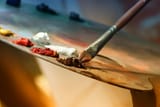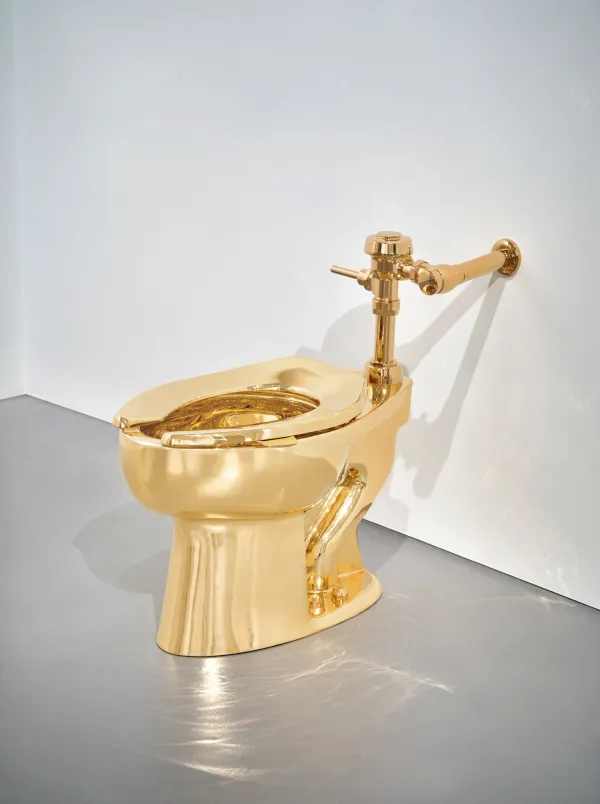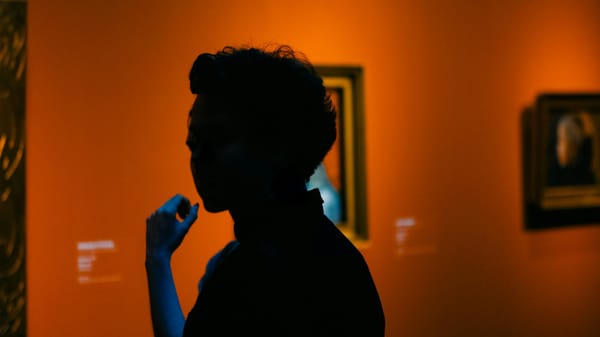Test Before You Build: Turn Concepts into Collectors
Use small, fast experiments to refine your work in public, gather high-value feedback, and create early access pathways that transform casual viewers into long-term collectors.

← Back to the Artist Masterplan
If part one was about flipping the script, part two is about precision. Building demand is one thing — shaping it so the right people are leaning in is another. This is where you stop throwing ideas into the void and start testing like a strategist.
Here, we go inside the methods artists use to refine a concept before committing months to it. You’ll see how to listen without losing your voice, how to pitch a vision instead of a product, and how to tell whether you’re attracting casual admirers or future patrons. The goal isn’t just buzz — it’s alignment, the kind that makes a curator clear a wall for you or a collector mark their calendar months in advance.
For members, this section unpacks the exact tools, conversations, and early-stage plays that take your art from “interesting” to “I have to be part of this.”
Pitch the Vision, Not Just the Work
Now, let’s bring this to the real world. Say you’re an artist launching something — maybe it’s your first solo show, maybe it’s a limited run of prints, or a brand-new project that feels like your soul cracked open and spilled onto canvas. And maybe, for now, you’re not selling directly to the everyday audience — maybe your real "customer" is the gallery owner, the curator, the brand, the collector, the gatekeeper.
That means your pitch has to shift.
You’re not saying, “Hey, buy my art.”
You’re saying, “Hey, here’s why this matters. Here's the story. Here's the data — maybe it's not spreadsheets, maybe it’s culture, trends, what's resonating. Here’s the movement I’m building. Here's why your space, your platform, your name should be part of that story.”
You’re not begging for attention — you’re offering value.
Let’s say you don’t even have the full collection finished yet. Doesn’t matter. Big opportunities move slow.
Big Opportunities Move Slow
That gallery isn’t hanging your work tomorrow anyway. So instead, you offer the vision. You package the insight, the moodboard, the research, the test pieces. You set up an experience — maybe an intimate preview, a “coming soon” waitlist, or even just a beautifully crafted concept deck.
Maybe you host a soft-launch Zoom, show the early sketches, talk about the process — not as a sales pitch, but as a human connection.
You're saying: "Come see what this could be. Let me show you why this matters. Let me collect feedback, and together we shape something that lands."
That’s what we call a needs analysis. It’s not a fancy term — it’s just listening before you ask. It's saying: “Let me understand you, your space, your audience — and let’s co-create something that works.”
And that whole first step? That’s already value.
You haven’t sold a single painting yet. But you’ve earned trust. You’ve created momentum. You’ve made them feel like they’re part of something before it even launches.
And that is powerful.
Testing Like a Pro
And here’s something I don’t think artists talk about enough — testing. Not the glamorous kind, not the “post it and hope it goes viral” kind. I mean real, intentional testing.
Let’s say you’ve got an idea for a series — maybe a visual story, maybe an installation, maybe even a book of poems. Before you pour six months into creating the whole thing… test it.
Run a set of Instagram posts, each one with a different title, different tone, different visual. You’re not launching. You’re listening. You’re watching what people click, what they save, what they DM you about.
If you’ve got 70 ideas, don’t try to guess which one hits. Run a poll, run ads if you’ve got the budget — even 50 bucks will tell you a lot. If you’re a musician, test hooks. If you’re a writer, test your opening lines. If you’re a painter, test color palettes or themes.
See, that’s what professionals do. They don’t just launch — they listen first. They test the cover before they write the book. They see what the energy is around an idea before going all in. Because what you think is your best idea might convert at 0.3%. And what you thought was a throwaway title — that might be the one people flock to.
And it might cost you, what, a hundred bucks to find out?
That’s the beauty of this moment we’re in. The tools we have now — social platforms, newsletter tests, ad platforms — they let us test 50 ideas in a weekend. You don’t need permission. You just need curiosity.
It’s Not Just What Works — It’s Who It Works On
And here’s the kicker: it’s not just about what people click — it’s who’s clicking. You might get more engagement on a trendy topic, but is it bringing in the right kind of audience? Are these people who would invest in your art, who see the value, who would show up to your exhibit or buy your zine? Or are they just scrolling for entertainment?
That’s the kind of nuance most people skip. But artists who get that — they win.
Sometimes you’ll run a test and one concept gives you leads for $5 each… and another gives you leads for $20 each. Most people would go, “Well, I’ll take the $5 leads.” But maybe the $5 ones are people who love free stuff and aren’t really your patrons. And maybe the $20 leads are curators, serious collectors, or collaborators who bring 10x the long-term value.
So now you’re not just testing what works — you’re testing who it works on.
The Situational Model (Deeper Insight Framework)
That’s why, when people join your waitlist or respond to a teaser post, ask them things. Use that moment to understand the “situational model.”
That’s a framework that changed how I think about everything. And it’s simple. Ask people:
- Where are you now?
- Where do you want to be?
- What’s been in your way?
- What are you considering as the next step?
These four questions tell you everything. If you're an artist selling commissions, this helps you understand the emotional state of your ideal client. If you're launching a course, a zine, or even a residency, you’ll understand why someone might say yes — and more importantly, why they might say no.
You can also ask price perception questions — not just “How much would you pay?” — but “What price would be so cheap you’d question the quality?” “What price feels fair?” “What price is so high it’d be out of reach?”
This gives you clarity. You’re no longer guessing. You’re not shouting into the void, hoping someone listens. You’re designing your offering around real insight.
Early-Stage Testing Tools
And it’s wild — this is something you can do without having anything “finished.” You can test ideas before you’ve created the art. You can build a waitlist before the series is even framed. That’s the power of this approach.
Shared Spaces: Start the Conversation
One of my favorite ways to do this is something I call a “discussion group.” Artists rarely think in these terms, but they should.
Let’s say you’re exploring a new concept — maybe you’re working on a series about climate grief, or identity, or digital permanence. Start a discussion group. Literally call it that: “Exploring Digital Permanence: A Discussion Group.”
Set up a private WhatsApp group or a Zoom invite. Invite people who care about the topic — other artists, potential collectors, curators, even just thoughtful humans. Let them know you’re hosting a space to share ideas, get feedback, and explore the themes.
Now what you’ve done — without needing a gallery, without needing press, without even finishing the work — is create a community around the concept. You’re no longer hoping people care. You’re involving them early. You’re building context. And people love being early to something real.
That’s what Gabriella did. She was in the wellness space, and she started a discussion group around fertility and natural conception. The group exploded — tens of thousands joined. That group became a book, which became a global business.
But this isn’t just about scaling. It’s about resonance. It's about giving your work a place to land.
Another guy, Max — he started a WhatsApp group for people in the world of family offices. Not artists, sure, but the principle applies. He said: “I want to gather thoughtful people around a niche topic.” No agenda. Just connection. And through that, he met some of the most influential investors in the world.
It’s the same for you. Whatever your medium is — sculpture, print, sound, installation — start the conversation. Host it. You don’t need permission.
The Assessment Format
And then there’s one more format I love — the assessment.
This is wildly underused by artists, but it’s incredibly effective. Think of it like this: people love discovering something about themselves. They love being invited to reflect, to be seen. That’s what your art does anyway, right? So let’s formalize it.
You could create an assessment that asks:
- What kind of emotional landscapes do you gravitate to in art?
- Are you drawn to stillness or chaos?
- Do you seek art to feel seen, challenged, soothed, provoked?
This doesn’t have to be some technical, multi-choice quiz. It can be poetic. It can be a reflective form — five questions that lead someone into your world. But what it does is begin a dialogue. It shows people where they are, and it invites them into what you’re making.
You could call it something like:
“Which era of my work belongs to you?”
“Where are you on the creative spectrum?”
“Which emotional chord do you resonate with?”
And from there, you get real data. You get names. You get interest. You can follow up. You can share the series you’re working on that matches their response. You can build anticipation for the next collection. It’s no longer just “Hey, I made this.” It becomes “Hey, I made this for people who see what you see.”
This is marketing that’s rooted in soul. It’s connection-led. And it works.
And the best part? You don't even need to have the finished piece, the final painting, the installation, the show. You can run these assessments while you're still in the sketchbook phase. You can collect this data before the collection is done. You can involve people in the process — and that makes them feel like they're part of the story.
Testing Helps You Create Better Art
Because that's really the future: co-creation, conversation, not broadcast. And that’s what people are hungry for. In a world flooded with content and noise, people are craving meaning. They're craving something that feels made for them.
So when you show up with a lens, with a point of view, with the kind of questions that invite people deeper — that's where art becomes magnetic. That’s how you sell out shows. That’s how you create collectors. That’s how you build a following that isn’t just numbers but people who are genuinely changed by what you do.
And here's the wild part — this whole model, this approach to testing, assessing, inviting… it doesn’t just help you sell. It helps you make better art. Because the more you learn about your audience, the more you learn about your own vision. The more you hear what resonates, the more you’re refined.
Not to bend yourself to fit an algorithm — never that. But to become even more you. More distilled. More sharp in your offering.
The 10% Rule
And when we talk about monetization in this space, especially for artists, one of the most important shifts to make is understanding that not everyone is your buyer — and that’s okay. You’re not making work for everyone. You’re not trying to please the whole street. You’re trying to connect deeply with your people, your collectors, your audience. And here’s the thing: the top 10% of your audience, they hold 60% of the money. That’s not some theoretical stat — it’s real. And when you look at your practice through that lens, things start to click.
You give value to the whole community. You share your process, your thoughts, your sketches, your insights — and that builds trust, depth, familiarity. But when it comes time to monetize? You create specific experiences, pieces, and offerings for that top 10%. The ones who resonate the deepest. The ones who want to go further with you. They want the original painting. They want the studio visit. They want the commission, the private viewing, the collector's circle. That’s who you create your limited edition, your intimate events, your premium offerings for.
And here’s where most artists get stuck — they build for the 90%. They listen to the 90%, they price for the 90%, and they burn out trying to serve people who were never meant to be their patrons. Instead, flip it. Offer free value generously, but build your business model around the 10% who are ready and excited to support you at a higher level.
It’s a fractal. It doesn’t matter what industry you're in — the pattern repeats. Even if you were only serving collectors or patrons, the same dynamic applies. The top 1% of your collectors will account for 15% of your total income, and the next 9% will account for another 45%. That’s 60% of your income from the top 10% of your people.
So if you try to build for everyone, you end up building for no one. You end up getting pulled toward the average. You’ll be told to price lower, to make more accessible versions, to cater to the masses — but those aren’t the people who’ll fund the next chapter of your practice. If you ask the crowd what you should charge, they’ll say $100. But if you ask the top 1%, they’ll say $5,000, $10,000, $20,000 — because they see the value, and they want to invest in you.
Design Your Business Around Your Top Fans
So the work becomes not just making your art, but designing ways to segment that audience — to know who your people are, to find the ones who resonate with the depth and vision of your work, and to let them in. Not just into your world, but into the value that you offer at the highest level.
The Artist’s Sweet Spot
Are there any other frameworks you’d use in those early stages—when you’re still figuring out if your idea, your vision, your art really has legs? Or even from a more emotional or psychological perspective—how do you know it’s something worth committing your life to?
Because it’s not just about finding an audience, right? It’s about deciding what mountain you want to climb for the next 10 years.
So, I use something called the “Artist’s Sweet Spot.” It's a kind of Venn diagram. And at the center is the intersection between three things: your passion, the problem you’re solving for people, and what they’re willing to pay for.
Passion. Problem. Payment.
You might be wildly passionate about something, but if it doesn’t solve a problem and no one’s willing to pay for it, you’ll eventually feel burnt out, disconnected, even resentful. You’ll start questioning your own value. On the flip side, you might be solving a problem and getting paid really well for it, but if it doesn’t light you up, you’re going to lose energy. You’ll wake up dreading the studio, feeling like you’re faking it, painting things just to sell.
And so, a lot of the time, we throw the baby out with the bathwater. We go from one extreme to the other—maybe leaving a design agency job to become a full-time oil painter, or from fine art to commercial illustration—and then wonder why we’re still feeling stuck.
What we actually need is to sit with the compromise, with the nuance. Not the most passionate, not the most lucrative, not the most convenient—but the intersection. That’s where sustainability lives.
There’s got to be some trade-offs. You can’t have it all at the extremes. You can have it all—but not all at once, not all in the same place. You have to design your practice, your creative business, your lifestyle, to strike a balance between those three circles: passion, problem, and payment.
Geography vs. Positioning
And you mentioned something earlier—geography. So, let me ask you this: does geography still matter for artists? Like, if you’re a painter in Cape Town, a musician in Jakarta, a filmmaker in rural Wales—do you need to move to London or LA or Berlin to have a shot at success?
It used to matter. For sure. Back in the day, when you thought about “making it” as an artist, you imagined getting discovered in New York, or studying in Paris, or moving to Tokyo. You had to physically be in the center of the art world, or close to the industry gatekeepers. But that model is breaking down.
Now, artists all over the world are launching careers from their living rooms. They’re creating digital art, running online exhibitions, building collector lists through email, licensing their work globally, live streaming their process, making music in bedrooms and finding fans on TikTok. It’s no longer about proximity—it’s about positioning.
The Gatekeepers Are Gone
And most importantly, it's about owning your audience. That is the new gatekeeper. If you’ve got 10,000 people who love what you do, you don’t need a gallery to validate you. You don’t need a label. You don’t need a film studio to greenlight your idea. You've got leverage.
You can crowdfund your next project. You can pre-sell your next body of work. You can host your own virtual exhibitions or pop-ups. It’s a new game—and it’s open to everyone.
The Rise of the Lifestyle Boutique Artist
So now we’re seeing this totally new breed of artist-entrepreneur. They might not be in New York or Paris. They might not be represented by a big-name gallery or signed to a major label. But they’ve got three, four, five thousand true fans. They’re shipping their work. They’re doing limited editions, commissions, custom drops. They’re licensing to brands. They’re teaching workshops, mentoring, running online courses. And they’re doing it all with six to twelve people—or sometimes just by themselves—with total creative freedom.
These are what I call “lifestyle boutique” artists. They’re not chasing mass-market fame. They’re not trying to be the next Beyoncé or Basquiat. But they’re profitable. They’re fulfilled. And they’re free.
Then there’s another type—the “performance artist-business.” Not performance art like the gallery definition, but in terms of scale. This is the artist who builds a creative company, usually with some kind of productized intellectual property or tech involved, and they scale it. They build a team. Maybe they raise funding. Maybe they exit. These are the folks who create design studios, creative SaaS products, production houses, or agencies that work with top brands. They’re still artists at heart—but they geek out on business and systems and growth. And they want that $10–100 million valuation.
But that’s not for everyone. You’ve got to love business if you want to go there. You’ve got to enjoy the acronyms: LTV, GTM, CAC. You’ve got to like building a sales pipeline and managing a team. And that’s a different energy than the romantic ideal of the solo artist in their studio.
The Artist’s Triangle
So for most artists—especially independent ones—what really brings joy, impact, and sustainability is finding that sweet spot. That place where your passion, the problem you solve, and what people are willing to pay for intersect. I call it the artist’s triangle: passion, problem, payment.
You might be obsessed with abstract portraiture, or designing wearable art, or scoring short films. That’s your passion. But to build a career around it, you also need to know what problem it solves—how it moves people, what it represents for them, how it connects, heals, decorates, transforms a space or an emotion. That’s the problem. And then, of course, payment—what’s the model that makes it sustainable? Is it collectors? Merch? Teaching? Patreon? Licensing? NFTs? You’ve got to find the intersection.
Because just being passionate isn’t enough. A lot of artists burn out because they’re passionate but disconnected from a value exchange. On the flip side, some artists only chase the commissions or the gallery system and they lose that passion. So the work gets stale. The magic’s gone. That’s why we find the triangle.
And once you’ve got that, you build around it. You create systems. A product ecosystem. You develop your body of work, your visual language, your story. You build your personal brand—not to be an influencer, but to be a key person of influence in your niche.
And again, this doesn’t mean millions of followers. It means clarity. It means consistency. It means people can discover you, understand what you’re about, feel a connection, and decide to support you—whether that’s through buying your art, commissioning a piece, attending your workshop, joining your Patreon, or just sharing your work.
Repetition Builds Legacy
And this brings us back to the idea of repetition. Repetition is everything. It’s not just creating once—it’s showing up again and again. Think about your favorite bands. How many times have they performed their most well-known songs? Over and over. But that’s what builds mastery. That’s what builds resonance. That’s what builds legacy.
The same applies to visual artists, writers, designers, filmmakers—whatever your craft is. You find your themes, your voice, your identity, and then you repeat it with love. You keep showing up. You keep getting better. You keep sharing.
Because here’s the truth: you’re not too late. You’re not behind. You’re not missing something. You’re standing on a mountain of value, right now. And most of us don’t even see it. We’re so focused on the next mountain, the next big thing, we forget to appreciate where we already are, and what we already have to say, to create, to share.
© ART Walkway 2025. All Rights Reserved.
→ Back to the Artist Masterplan
→ Part 1: Flip the Script: Build Demand Before the Work Exists
→ Part 2: Test Before You Build: Turn Concepts into Collectors
→ Part 3: Design Your Capacity: The Business of Resonance





